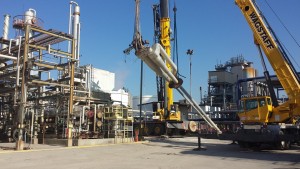 Print a Sign-In Sheet | Spanish Version
Print a Sign-In Sheet | Spanish Version
Rigging may look like an easy operation, but do not be fooled. Many people thinking “anyone can do it” have lost fingers or hands or have suffered more serious injuries.
Get Your Signals Straight
Appoint one member of the crew to act as signalman and instruct the crane operator not to accept signals from anyone else. The signalman must not order a move until getting an “all ready” from each crew member. Each worker, in turn, must be in the clear before giving an “all ready” to the signalman. If you must hold on to a chain, sling, choker, or other object to maintain tension, be sure your hands and feet are clear of pinch points before giving an “all ready.”
Protect Your Hands
If it is not possible to release the chain, sling, or choker, make sure your hand is clear of pinch points. Keep your hand far enough away so that frayed wires or splinters on the chain cannot catch your glove and jerk your hand into a pinch point.
Watch Out for Rock and Roll
It is almost impossible to position the hook exactly over the load center. Be aware of swing or roll. Anticipate the direction of the swing or roll and work away from it. Never place yourself between material, equipment, or other stationary objects and the load. Stay away from stacked material that may be knocked over by a swinging load.
Stay Out from Under
Never get under a suspended load or a crane’s boom. Chances are nothing will break, but are you willing to bet life and limb that it won’t?
Set It Down Carefully
When it is necessary to guide a load, use a tag line or hook. If you must walk with a load, keep it as close to the ground as possible. Before moving a load, inspect the area where the load is to be landed. Remove unnecessary blocks or other objects that may fly up when struck by the load. When lowering or setting a load, keep your feet and all other parts of your body from under the load. Set the load down easily and slowly. Then, if the load rolls on the blocking, it will shift slowly, and you will be able to get away.
KEMI does not assume liability for the content of information contained herein. Safety and health remain your responsibility. This information is to be used for informational purposes only and not intended to be exhaustive or a substitute for proper training, supervision, or manufacturers’ instructions/recommendations. KEMI, by publication of this information, does not assume liability for damage or injury arising from reliance upon it. Compliance with this information is not a guarantee or warranty that you will be in conformity with any laws or regulations nor does it ensure the absolute safety of any person, place, or object, including, but not limited to, you, your occupation, employees, customers, or place of business.

